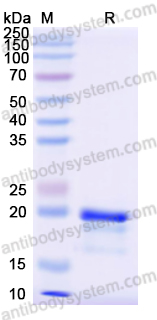Catalog No.
YHC43701
Expression system
E. coli
Species
Homo sapiens (Human)
Protein length
Thr373-Glu540
Predicted molecular weight
20.14 kDa
Nature
Recombinant
Endotoxin level
Please contact with the lab for this information.
Purity
>90% as determined by SDS-PAGE.
Accession
P09874
Applications
ELISA, Immunogen, SDS-PAGE, WB, Bioactivity testing in progress
Form
Lyophilized
Storage buffer
Lyophilized from a solution in PBS pH 7.4, 1mM EDTA, 4% Trehalose, 1% Mannitol.
Reconstitution
Reconstitute in sterile water for a stock solution. A copy of datasheet will be provided with the products, please refer to it for details.
Shipping
In general, proteins are provided as lyophilized powder/frozen liquid. They are shipped out with dry ice/blue ice unless customers require otherwise.
Stability and Storage
Use a manual defrost freezer and avoid repeated freeze thaw cycles. Store at 2 to 8°C for frequent use. Store at -20 to -80°C for twelve months from the date of receipt.
Alternative Names
PARP-1, Protein poly-ADP-ribosyltransferase PARP1, DNA ADP-ribosyltransferase PARP1, Poly [ADP-ribose] polymerase 1, PPOL, Poly[ADP-ribose] synthase 1, ADPRT 1, ADP-ribosyltransferase diphtheria toxin-like 1, ADPRT, PARP1, NAD(+) ADP-ribosyltransferase 1, ARTD1
FOXD3 promotes homologous recombination repair and genomic stability by facilitating MRE11-mediated DNA end resection., PMID:40515531
Dihydrocapsaicin Enhances Tumor Necrosis Factor-α-Induced Apoptosis and G1 Cell Cycle Arrest in Human Cervical Cancer Cells Through TAK1-Mediated NF-κB and EGFR Pathways., PMID:40507823
Polystyrene microplastics induces the injury of human corneal epithelial cells through ROS-mediated p53 pathway., PMID:40503930
Erianin Protects Human Umbilical Vein Endothelial Cells From Oxidized Low-Density Lipoprotein-Induced Apoptosis and Oxidative Stress Through Activation of Nuclear Factor E2-Related Factor 2 Signaling., PMID:40490908
Targeting glioblastoma multiforme cells with pharmacological ascorbate: Disrupting DNA damage response and mTOR cascades via extracellular H2O2., PMID:40490203
N6-methyladenosine reader YTHDF3-mediated CEBPA translation maintains genomic stability and stem cell function to prevent liver injury., PMID:40488955
The linker histone chaperone Prothymosin α (PTMA) is essential for efficient DNA damage repair and the recruitment of PARP1., PMID:40474236
Computational and Molecular Profiling of the Anticancer Properties of Thuja occidentalis L. From Southern Punjab., PMID:40468803
Fused pyrido[3,4-D]pyrimidine moiety with phthalazinone ring accelerate dual inhibition of PARP1 and CDK4 in triple-negative breast cancer: a hybrid design with computational investigation through molecular modeling and quantum mechanics., PMID:40465091
[Mechanism of vanillic acid against cardiac fibrosis induced by isoproterenol in mice based on Drp1/HK1/NLRP3 and mitochondrial apoptosis signaling pathways]., PMID:40461229
BRCA2 reversion mutation-independent resistance to PARP inhibition through impaired DNA prereplication complex function., PMID:40460119
FGFR3-induced Y158 PARP1 phosphorylation promotes PARP-inhibitor resistance via BRG1/MRE11-mediated DNA repair in breast cancer models., PMID:40460005
Quercetin Protects against Ethanol-induced Neurodegeneration in Adult Rat Cortex., PMID:40454497
C1QBP promotes apoptosis of goat fetal turbinate cells via inhibiting the expression of TRIM5 or TNFSF10., PMID:40454173
Harnessing miRNA dynamics in HIV-1-infected macrophages: Unveiling new targeted therapeutics using systems biology., PMID:40453371
PRMT4/CARM1 Is a Novel Factor Promoting DNA Double-Strand Break Repair., PMID:40452456
MitoQ for vitiligo by mitigating PARP1 translocation aberrations: Network pharmacology and experimental validation., PMID:40451398
Therapeutic approach for triple-negative breast Cancer through poly (ADP-ribose) Polymerase-1 inhibitors: Current update., PMID:40451015
Poly(ADP-ribose) polymerase-1 (PARP-1) gene polymorphisms in schizophrenia: A case-control study in the Turkish population., PMID:40441241
PARP1-PROTACs providing novel opportunities in precision oncology by targeting DNA damage response., PMID:40440930
Therapeutic role of Crateva religiosa in diabetic nephropathy: Insights into key signaling pathways., PMID:40435181
Approaches to repurposing reverse transcriptase antivirals in cancer., PMID:40432477
Mechanisms of DNA Damage Recognition by UDG and PARP1 in the Nucleosome., PMID:40427542
ATR Deficiency Impairs DNA Damage Repair and Accelerates Cellular Senescence in Bovine Mammary Epithelial Cells, Leading to Lactation Dysfunction., PMID:40427296
Fibrinogen exacerbates α-synuclein aggregation and mitochondrial dysfunction via alpha5beta3 integrin in Parkinson's disease., PMID:40425084
Bioassay-Guided Procedure Coupled with HR-ESIMS Dereplication for Isolation of Antiproliferative Bromo-Tyramine Derivative from Aplysina cauliformis., PMID:40422777
Identification of novel gene expression patterns and pathways involved in PARP-1 inhibitor resistance., PMID:40402278
PARylation of POLG Mediated by PARP1 Accelerates Ferroptosis-Induced Vascular Calcification via Activating Adora2a/Rap1 Signaling., PMID:40401372
Genetic insights support PARP1 as a mediator in the protective association of ATP-citrate lyase inhibitors with melanoma., PMID:40399559
Identification of Hub Genes and Pathways Associated with Ageing in Diabetic Encephalopathy Based on Transcriptome Analysis., PMID:40397335
Widespread false negatives in DNA-encoded library data: how linker effects impair machine learning-based lead prediction., PMID:40395382
A Transcriptional Variant of Anaplastic Lymphoma Kinase Promotes Apoptosis in Ovarian High-Grade Serous Carcinoma., PMID:40387841
HELQ upregulates PARP1 to drive platinum resistance and predict therapeutic response in ovarian cancer., PMID:40381483
Measuring PARP1 mobility at DNA damage sites by segmented fluorescence correlation spectroscopy., PMID:40380768
Parp1 deletion rescues cerebellar hypotrophy in xrcc1 mutant zebrafish., PMID:40379758
Gal-1 promotes lung cancer cell survival by enhancing PARP1/H1.2 interaction to promote DNA repair upon DNA damage response., PMID:40365664
Binding Interaction and Stability Analysis of Quercetin and its Derivatives as Potential Inhibitors of Triple Negative Breast Cancer (TNBC) against PARP1 Protein: An in-silico Study., PMID:40353470
[Oxocrebanine inhibits proliferation of hepatoma HepG2 cells by inducing apoptosis and autophagy]., PMID:40350949
Joining of DNA breaks- interplay between DNA ligases and poly (ADP-ribose) polymerases., PMID:40347914
HBV-induced N6 methyladenosine modification of PARP1 enhanced AFB1-related DNA damage and synergistically contribute to HCC., PMID:40344782
Evaluating Bis-Phenacyl Bromide-Based Bis-Heterocyclic Templates as Anticancer Prototypes and Potential PARP1 Inhibitors., PMID:40344375
Novel C-3 and C-20 derived analogs of betulinic acid as potent cytotoxic agents: design, synthesis, in vitro and in silico studies., PMID:40343306
Coilin and SUMOylation influence PARP1 dynamics and the DNA damage response., PMID:40342165
METTL3-dependent m6A modification of SNAP29 induces "autophagy-mitochondrial crisis" in the ischemic microenvironment after soft tissue transplantation., PMID:40340690
Targeting DNA damage sensors for cancer therapy., PMID:40339280
Proteogenomic reprogramming to a functional human blastomere-like stem cell state via a PARP-DUX4 regulatory axis., PMID:40338744
Multiomics analysis unveils an inosine-sensitive DNA damage response in neurogenic bladder after spinal cord injury., PMID:40338665
Mitigating T cell DNA damage during PARP inhibitor treatment enhances antitumor efficacy., PMID:40333991
Self-promoted tumor-targeting nanomedicine activates STING-driven antitumor immunity via photodynamic DNA damage and PARP inhibition., PMID:40321187
WDR11-DT enhances radiosensitivity via promoting PARP1 degradation and homologous recombination deficiency., PMID:40320037

